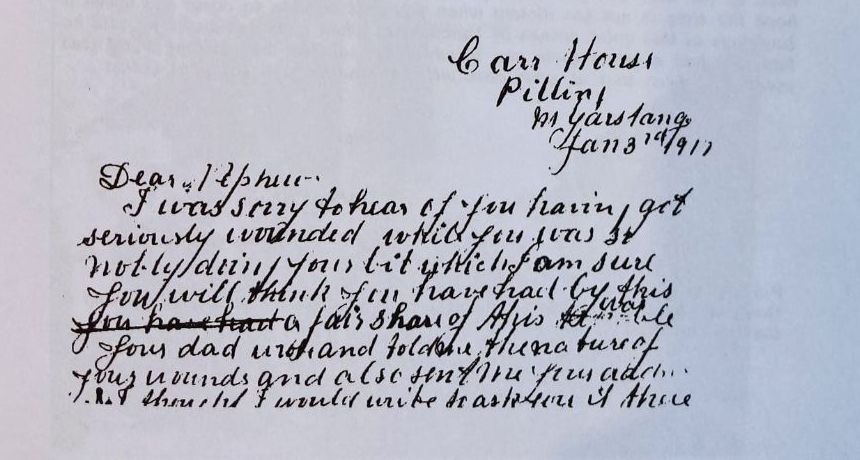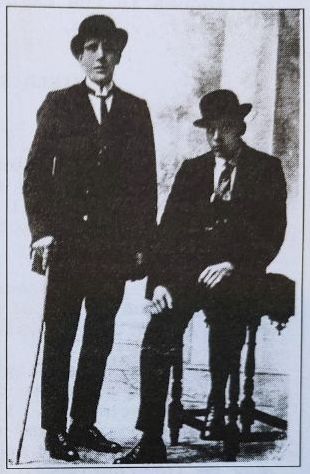MEMORIES OF THE GREAT WAR
By Sophia and Peter Sherdley
As the twentieth century and second millennium both draw to a close, it is perhaps a good time to reflect on some of the darker aspects of our history in the hope that the mistakes which caused so many of them will not be repeated. In particular I am thinking of the conflict of eighty-five years ago, dubbed, somewhat naively, "the war to end all wars".
There can have been few families in this country, and in many others, who did not feel it's effects among their number, and mine was no exception. Correspondence recently come to light, has given us an interesting insight into the fate of two brothers. The tenancy of Carr House Farm, Green Dicks Lane, Pilling was taken over in 1917 by John Smalley Haworth, late of Dewhurst Farm, Great Harwood, and these notes relate to two of his nephews, Thomas Edmund Haworth, age 22, and his younger brother John Robert, age 19.
Thomas Edmund, or "Ned", joined the 15th Battalion, Lancashire Fusiliers in 1916, just short of his twentieth birthday, and was posted to the Western front in July, 1916. He seems to have survived the horrors of trench warfare well enough until December, 1917, by which time he had been promoted to corporal, but on the 17th of this month his parents received an Army letter informing them their son was in hospital with "gunshot wounds, multiple, severe". By January, 1918, he had been transferred to a Red Cross Hospital in Cawston, Norfolk, and it is to there that his uncle at Carr House Farm wrote to him.

The letter is dated Jan 3rd 1917, but this is an error, as we know it must have been 1918, but which of us has not made the same mistake in the first days of a new year! A full and more legible transcript of the letter is appended.
Carr House, Pilling,
Nr Garstang.
Jan. 3rd 1917
Dear Nephew,
I was sorry to hear of you having got seriously wounded while you was so nobly doing your bit which I am sure you will think you have had by this a fair share of this. When your dad wrote and told me the nature of your wounds and also sent me your address so I thought I would write to ask if there is anything I can send you that would be any use to you either butter eggs apples chickens or anything else you are in need of. I should be more than pleased to send any thing you can mention but you see I am at a loss to know what to send you but as I am desirous of doing something for you in your trouble and suffering I should be pleased if you would say by return what would be best for me to send. If you was not so far away I would come to see you but as you will well understand we are very busy we have only just finished wheat seeding and we are just making a start with our stubble ploughing and we have 15 acres of grassland to plough up over the 65 acres we have had under cultivation this year making 80 in all. Thomas as had his calling up papers but he got exempted till end of past Dec but how he will go on further I can't say. But as he is the only cowman here besides what I can do among other work and seeing that we have between 70 and 80 cows to look to I think he will not be called up for a bit yet. In conclusion I sincerely hope by the time you get this you are on the road to a speedy recovery and hope the time is not bar distant when you will be able to come and spend a few days in this quiet corner of Lancashire. When your dad wrote he said he had just had a letter from you in which he said he was alright and I was pleased to hear that as your care will be hard enough for your folks.
P.S.
I remain
Yours Truly,
John S. Haworth
Don't be shy for anything you want as you know I can send you anything in the line of eatables.
He recovered from his wounds, but never returned to active service, spending the remainder of the war in England with the Military Police. After the war he returned to Great Harwood and spent the rest of his days there as a joiner and carpenter.

"Ned" standing, John on right seated
The story of his younger brother John is altogether more tragic. He joined up on 19th September, 1916, age 17 years 11 months and was posted as a machine gunner with the 35th Battalion, Machine Gun Corps (Infantry), in which capacity he was caught up in the German Offensive of March 25th 1918, thirteen days after his last known letter home. The machine gunners were ordered to hold as long as possible to let the bulk of the army escape, but were eventually over-run. While some of his colleagues escaped, John was badly injured by shrapnel and had to be abandoned. Unfortunately, he was never seen again, and nor was his body ever found. Naturally, his family hoped for the best, and a photograph which eventually appeared in the inter- national press, of English prisoners on a German railway station showed one prisoner who looked rather like John.

The indicated prisoner thought to be John Haworth
Alas, prolonged enquiries proved this to be a false hope, and eventually it had to be accepted that he had perished. He is now commemorated as one of those with no known grave, on the Poziers Memorial, Somme, France, together with over 500 of his colleagues in the Machine Gun Corps.
